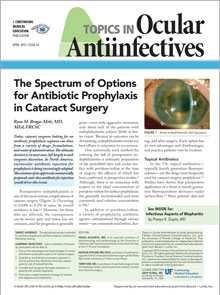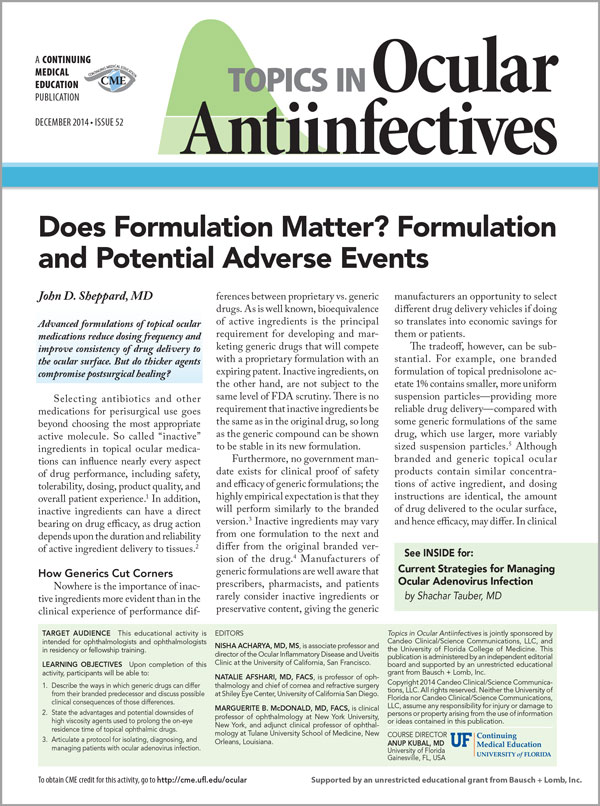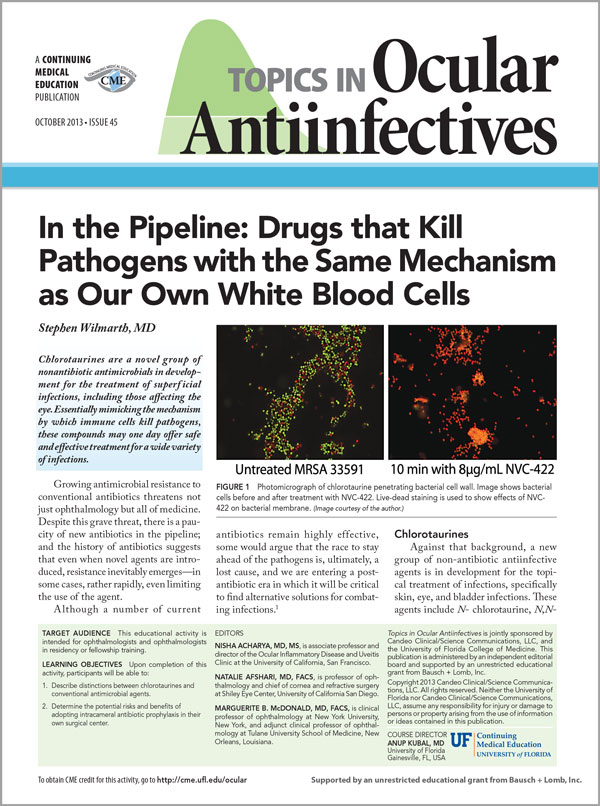Issue 70 - August 2019
Contact Lens-Related Infections
Deepinder K. Dhaliwal MD, L.Ac and Tarika Thareja, MD
Medical and Ophthalmic Implications of Ocular Surface Microbiota
Joseph M. Blondeau, PhD
Learning Objectives:
Describe the risk factors for contact lens-related infections and the signs and symptoms for differential diagnosis of the main types of presentations.
Describe the therapeutic management for contact lens-related infections and advise patients to prevent future occurrences.
Understand the importance of ocular and gut microbiota in prevention and pathogenesis of diseases.
Describe microbiologic consequences of contact lens wear and dry eye disease (DED).
Issue 69 - December 2018
Update on Prevention and Management of Blebitis
Leon W. Herndon, Jr., MD
A Review and Update of EKC
Nambi Nallasamy, MD
Learning Objectives:
Optimize peritrabeculectomy clinical care to minimize risk for bleb-related infection.
Recognize risk factors, signs, and symptoms of bleb-related infection.
Diagnose and manage individual cases of EKC.
Implement procedures to prevent the spread of adenovirus within healthcare facilities.
Issue 68 - August 2018
Advances in Understanding and Managing Blepharitis
Preeya K. Gupta, MD
Intracameral Antibiotics in Cataract Surgery
Neal H. Shorstein, MD
Learning Objectives:
Develop a risk-stratified plan for long- and short-term blepharitis treatment.
List potential approaches to Demodex infestation.
Describe current trends and practice patterns of antibiotic prophylaxis against endophthalmitis during cataract surgery in the US.
Improve prophylaxis of endophthalmitis in cataract surgery with appropriately selected intracameral antibiotics.
Issue 67 - April 2018
PACK-CXL: Corneal Collagen Crosslinking for Infectious Keratitis
Erica Bernfeld, MD
Common Infections in the Presence of Chronic Ophthalmic Disease
Melissa B. Daluvoy, MD
Learning Objectives:
Interpret the available research on corneal collagen crosslinking for infectious keratitis.
Explain the proposed mechanisms by which photoactivated riboflavin may work to treat corneal infection.
Recognize medication-related risk factors for common infections and counsel patients with a chronic ophthalmic disease on their risk.
Manage common infections more diligently to prevent serious complications in patients with another chronic ophthalmic disease.
Issue 66 - December 2017
Antibiotic Therapy in Acute Conjunctivitis
Misbah Keen, MD, MBI, MPH and Matthew Thompson, MBChB, MPH, DPhil
Compounded Drugs: Risks and Benefits
Charles Leiter, Pharm.D.
Learning Objectives:
Discuss current diagnostic and treatment issues in acute conjunctivitis.
Improve management of acute conjunctivitis by adopting evidence-based prescribing.
Describe the benefits and risks associated with the use of compounded ophthalmic antibiotics.
Describe strategies to minimize the risks of using compounded antibiotics.
Issue 65 - October 2017
Ocular Infections in Immunocompromised Hosts
Anat Galor, MD, MSPH
Long-term Management of Herpes Zoster Ophthalmicus
Elisabeth J. Cohen, MD
Learning Objectives:
Uncover possible immune deficiency and infection risk factors in their patients.
More quickly and accurately diagnose infection in immunocompromised patients.
Describe the shifting trends in the epidemiology of herpes zoster.
Educate and advise eligible patients to encourage adoption of zoster vaccine.
Issue 64 - December 2016
HIV-associated Ocular Surface and Anterior Segment Infections
Ron Adelman, MD, MPH, MBA
Topical Ophthalmic Antibiotics: Current Options and Role of Fortified Antibiotics
Bennie H. Jeng, MD, MS
Learning Objectives:
Describe the clinical presentation of common infections of the ocular surface and anterior segment associated with HIV/AIDS.
Describe the key elements in diagnosing and treating infections of the ocular surface and anterior segment in patients suspected of HIV infection.
Employ a combination of fortified agents to treat potentially serious corneal ulcers.
Issue 63 - November 2016
Fluoroquinolone Generations: What’s Next?
Parag A. Majmudar, MD
Applying MIC in Antibiotic Drug Selection and Resistance Prevention
Joseph M. Blondeau, PhD
Learning Objectives:
Factor antibiotic generation into clinical decision-making in the treatment and prevention of ocular infection.
Recognize limitations of generational antibiotic categorization.
Explain changing trends in antibiotic resistance to common ocular pathogens and the techniques used to establish these.
Describe strategies for minimizing antibiotic resistance through changes in clinical practice.
Issue 62 - September 2016
Intraocular Antibiotics for Cataract Surgery Prophylaxis
William B. Trattler, MD
Keratoconjunctivitis and Blepharokeratoconjunctivitis
Raj K. Goyal, MD, MPH
Learning Objectives:
Analyze the advantages and disadvantages of currently available intraocular antibiotic prophylaxis methods.
Choose appropriate antibiotic prophylactic regimen in cataract surgery based on efficacy and safety considerations.
Improve diagnosis and management of KC and BKC.
Identify and mitigate risk factors for ocular surface infection.
Issue 61 - June 2016
Preventing and Managing Bleb-related Infections
Sameh Mosaed, MD
Generic vs. Branded Antibiotics: Do the Differences Matter?
John R. Wittpenn, MD
Learning Objectives:
Articulate risk factors for bleb-related infection.
Detect and take appropriate initial steps to manage bleb leak and related infection.
Improve clinicians’ drug selection by identifying patient/disease situations in which there may be clinical reasons to consider branded drug rather than generic.
State two reasons why differences in the formulations may matter more for topical ocular drugs than oral agents.
Issue 60 - April 2016
Flap-related Infections
Steven Schallhorn, MD
Factors in Infectious Complications of Corneal Transplant
Bennie H. Jeng, MD
Learning Objectives:
Explain changing trends in infectious keratitis following LASIK.
Minimize the risk of flap-related infections in LASIK patients by improving surgical and clinical approaches.
Describe factors related to the increase in fungal infection incidence following corneal transplantation.
Reduce risk for bacterial and fungal infection in corneal transplant recipients.
Issue 59 - March 2016
Herpetic Anterior Uveitis
C. Stephen Foster, MD, FACS
Pragmatic Microbiology for Eyecare Providers
Deepinder K. Dhaliwal, MD
Learning Objectives:
Recognize a herpetic etiology in patients with anterior uveitis based on distinctive clinical findings.
Formulate the appropriate treatment strategy for presumed or proved herpetic anterior uveitis to reduce tissue damage and serious complications.
Obtain an adequate ocular tissue sample to identify pathogens present in superficial ocular infections.
Determine which cases are most in need of microbiology laboratory assessment.
Issue 58 - December 2015
The Human Microbiota: New Frontiers in Ophthalmology and Beyond
Rob Knight, PhD
Acanthamoeba Keratitis: Risk Factors, Diagnosis, and Medical Therapy
John E. Sutphin, Jr., MD
Learning Objectives:
Discuss the therapeutic potential associated with microbiome modulation.
Describe the status of ocular surface microbiome characterization.
Make timely diagnosis of Acanthamoeba keratitis based on patient’s history and clinical findings.
Choose appropriate antimicrobial therapy for patients diagnosed with Acanthamoeba keratitis.
Issue 57 – October 2015
Keeping MRSA in Check
Francis S. Mah, MD
Exotic Ocular Infections: Beyond the Tropics
Sivakumar R. Rathinam, PhD
Learning Objectives:
Identify patients at risk for MRSA colonization.
Design strategies to reduce MRSA transmission in the clinic and operating room.
Identify signs and symptoms of exotic ocular infections that are present in the West.
Conduct a thorough history when exotic infection is suspected.
Issue 56 – August 2015
Atypical Organisms in Postoperative Infections
Virender Singh Sangwan, MD
The Quinolone Antibiotics: Past, Present, and Future
Christopher N. Ta, MD
Learning Objectives:
Distinguish presentation of typical vs. atypical postoperative infection.
Lower their rates of missed diagnosis of rare organisms.
Make maximally effective treatment decisions, employing both the older and newer generation fluoroquinolones.
Design treatment protocols that minimize the risk of provoking fluoroquinolone resistance.
Issue 55 – June 2015
Polymerase Chain Reaction (PCR) in Ophthalmology
Janet L. Davis, MD, MA
Infectious Scleritis: A Review and Update
Anat Galor, MD
Learning Objectives:
Define a role for PCR within their own practices
Describe the types of PCR in current use
Identify clues that should raise suspicion of infectious scleritis
Discuss when to obtain a culture of conjunctival or corneal scrapings in cases of potential infectious scleritis
Issue 54 – April 2015
The Spectrum of Options for Antibiotic Prophylaxis in Cataract Surgery
Rosa M. Braga-Mele, MD, MEd, FRCSC
Infectious Aspects of Blepharitis
Preeya K. Gupta, MD
Learning Objectives:
Discuss the advantages and disadvantages of current antiinfective prophylaxis options for cataract surgery.
Establish an antiinfective prophylaxis approach in clinical practice that effectively minimizes cataract patients’ risk of endophthalmitis.
Consider and recognize Demodex infestation in patients with anterior blepharitis.
Formulate a staged treatment strategy for patients with staphylococcal blepharitis.
Issue 53 – March 2015
Culturing Ocular Infections in the 21st Century
Joseph Blondeau, PhD
Advances in Managing Adenovirus Ocular Infections
Shachar Tauber, MD
Learning Objectives:
Refine their practice of ocular culture and transport for a range of infection types.
Interpret reports from microbiologic laboratory more effectively.
Name two factors that distinguish possible treatment options for adenovirus conjunctivitis.
Issue 52 – December 2014
Does Formulation Matter? Formulation and Potential Adverse Events
John D. Sheppard, MD
Current Strategies for Managing Ocular Adenovirus Infection
Shachar Tauber, MD
Learning Objectives:
Describe the ways in which generic drugs can differ from their branded predecessor and discuss possible clinical consequences of those differences.
State the advantages and potential downsides of high viscosity agents used to prolong the on-eye residence time of topical ophthalmic drugs.
Articulate a protocol for isolating, diagnosing, and managing patients with ocular adenovirus infection.
Issue 51 – October 2014
Pseudomonas aeruginosa Corneal Infection
Linda D. Hazlett, PhD
Mechanisms and Clinical Implications of Antibiotic Resistance
Joseph M. Blondeau, PhD
Learning Objectives:
State two virulence factors produced by P. aeruginosa.
Identify corneal ulcer patients at high risk for P. aeruginosa keratitis and promptly initiate appropriate antimicrobial treatment.
Devise effective strategies for antimicrobial selection in an environment that is becoming increasingly rife with drug-resistant pathogens.
Issue 50 – August 2014
Current Thinking on the Prevention and Treatment of Staphylococcus aureus Ocular Infection
Francis S. Mah, MD
Innate Infectious Defenses of the Ocular Surface
Jillian F. Meadows, OD, MS; Kelly K. Nichols, OD, MPH, PhD
Learning Objectives:
Select appropriate agents for the empirical treatment of suspected MRSA infections.
Provide meaningful guidance to patients for maintaining their normal ocular surface protective mechanisms
Issue 49 – June 2014
Emerging Ocular Pathogens and the Ocular Surface Microbiome
Eduardo Alfonso, MD; Ying Guo, MBBS, PhD
The Role of Bacteria in the Pathogenesis of Blepharitis
Sharmini Balakrishnan, MD; Stephen C. Pflugfelder, MD
Learning Objectives:
Recognize the potential for MRSA infection and select appropriate antibiotics for empirical treatment prior to receipt of culture results.
Select appropriate antibiotics for the management of blepharitis.
Issue 48 – April 2014
Overnight Contact Lens Wear and Microbial Keratitis: Two Views
Bruce H. Koffler, MD; Helen K. Wu, MD
Viral Chorioretinitis: Current Approaches to Diagnosis and Management
Thomas Albini, MD
Learning Objectives:
Evaluate orthokeratology as an option for the reduction of myopia progression in young patients.
Select antiviral therapy and formulate appropriate treatment plan for patients with acute retinal necrosis (ARN) or CMV retinitis
Issue 47 – February 2014
Lessons from an Atypical Presentation of Herpetic Ocular Disease
Christopher Rapuano, MD
Topical Ophthalmic Antibiotics: Current Options and Role of Fortified Antibiotics
Bennie Jeng, MD
Learning Objectives:
Reduce patient morbidity through earlier detection of atypical ocular viral disease.
Employ a combination of fortified agents to treat potentially serious corneal ulcers.
Issue 46 – November 2013
Sound Ocular Antibiotic Use in an Environment of Widespread Resistance
John Affeldt, MD
Ocular Herpes Simplex: Current Thinking on Pathophysiology and Management
Christopher Rapuano, MD
Learning Objectives:
Improve outcomes in patients with ocular infections by taking the growing prevalence of multidrug resistant organisms into account when planning antibiotic treatment.
Employ key strategies for the treatment of infectious vs. inflammatory HSV keratitis.
Issue 45 – October 2013
In the Pipeline: Drugs that Kill Pathogens with the Same Mechanism as Our Own White Blood Cells
Stephen Wilmarth, MD
Compounded Antibiotics: Risks and Benefits
Nick Mamalis, MD
Learning Objectives:
Describe distinctions between chlorotaurines and conventional antimicrobial agents.
Determine the potential risks and benefits of adopting intracameral antibiotic prophylaxis in their own surgical center.
Issue 44 – September 2013
The Surprising Power of Bacterial Biofilms
Regis P. Kowalski, MS, [M]ASCP; Eric G. Romanowski, MS; Robert M.Q. Shanks, PhD
Polymicrobial Ocular Infection
John Sheppard, MD
Learning Objectives:
Explain biofilm resilience, specifically, a biofilm’s high tolerance of antibiotic therapy and discuss the clinical importance of biofilms in device-related infections.
List three risk factors for polymicrobial infection.
Identify diagnostic techniques for ocular infection.
Describe organisms that are associated with one another in concomitant infections.
Issue 43 – August 2013
Combination Multidrug Therapy to Combat Increasing Drug Resistance: A Double-Edged Sword?
Terrence P. O’Brien, MD
Rosacea and Ocular Infection
Preeya K. Gupta, MD
Learning Objectives:
Employ more effective regimens for the prevention and treatment of ocular infections, particularly infections caused by antibiotic-resistant bacteria.
Identify and treat the infectious complications of ocular rosacea.
Issue 42 – July 2013
Corneal Collagen Crosslinking for Infection
Karim Makdoumi, MD, PhD
Antimicrobial Management of Patients with Ocular Trauma
Swati J. Parekh, MD; Jai G. Parekh, MD, MBA
Learning Objectives:
List three clincal situations in which photochemical therapy may be of benefit.
List four factors that may increase a patient’s risk of infection after an open globe injury.
Take preventative measures, including prompt wound closure and early use of systemic and topical antibiotics, to reduce the risk of posttraumatic endophthalmitis.
Issue 41 – June 2013
The Positive Benefits of a Negative Culture
John M. Blondeau, PhD
Optical Biopsy for the Diagnosis of Corneal Infections
Elmer Y. Tu, MD
Learning Objectives:
List three potential causes of a negative bacterial culture.
Discuss the positive uses of a negative culture.
Institute appropriate therapy earlier in the course of challenging cases of infectious keratitis through use of optical biopsy to make or confirm diagnoses.
Identify clinical situations in which confocal microscopy is likely to be of benefit.
Issue 40 – May 2013
Infectious Complications of Corneal Transplants
Francis S. Mah, MD
Ocular Cytomegalovirus Infection in Immunocompetent Patients
Chee Soon Phaik, MD
Learning Objectives:
List and discuss risk factors for infection following penetrating and lamellar keratoplasty.
List the most common pathogens associated with anterior uveitis and corneal epitheliitis.
Compare and contrast the timing of intraocular infections in regards to the source of infection.
Discuss the diagnostic approach to anterior uveitis and corneal epitheliitis.
List and discuss the indications for various treatment modalities for anterior uveitis and corneal epitheliitis.
Issue 39 – April 2013
Treatment of Epidemic Keratoconjunctivitis
Stephen C. Kaufman, MD, PhD
Generic vs. Branded Antibiotics: Are There Differences? Do They Matter?
John R. Wittpenn, MD
Learning Objectives:
Make more accurate diagnoese of EKC through improved use of clinical evidence and advanced diagnostic tools.
Improve EKC treatment and patient counseling to lessen patient discomfort and prevent spread of EKC and associated ocular morbidity.
Improve clinician’s drug selection by identifying patient/disease situations in which there may be clinical reasons to consider branded drug rather than generic.
State two reasons why differences in teh formulations may matter more for topical ocular drugs than oral agents.
Issue 38 – March 2013
The Quinolone Antibiotics: Past, Present, and Future
Christopher N. Ta, MD
Intracameral Prophylaxis: The ESCRS Study in Perspective
Peter Barry, FRCS
Learning Objectives:
Make maximally effective treatment decisions, employing both the older and newer generation fluoroquinolones.
Design treatment protocols that minimize the risk of provoking fluoroquinolone resistance.
Describe the benefits and risks of intracameral cefuroxime prophylaxis in cataract surgery.
Evaluate the impact of adopting cataract prophylaxis regimen that incorporates intracameral antibiotic injection.
Issue 37 – February 2013
Herpectic Keratitis Following Laser Refractive Surgery
Herbert E. Kaufman, MD
Atypical Ocular Infections
Eduardo Alfonso, MD
Learning Objectives:
Reduce the risk of herpetic keratitis recurrence as a consequence of excimer laser refractive surgery in patients with a history of herpesvirus outbreaks.
Describe an appropriate prophylactic regimen for a refractive surgery candidate with a history of epithelial HSV keratitis.
Describe risk factors for acquisition of atypical ocular infections.



































